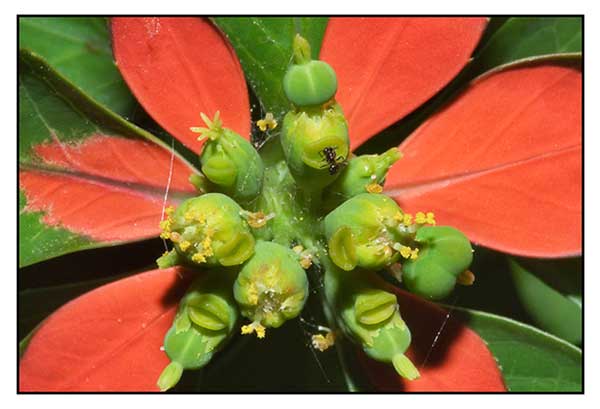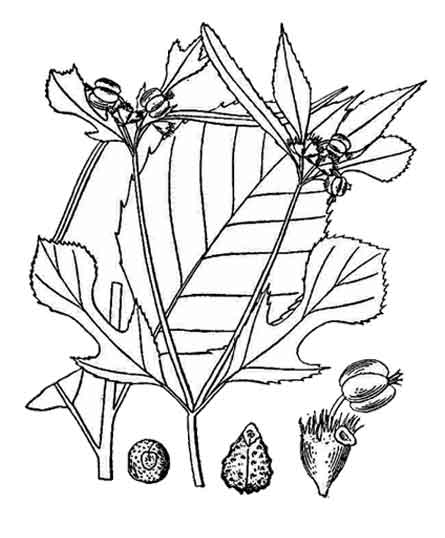 Gen info Gen info
Etymology: The genus name Euphorbia dates back to 30 BC when Pinio II, King of the Mauritania region named a local African plant Euphorbia to honor Euphorbus, a renowned medical doctor who discovered the medicinal properties of Euphorbia resinifera. Linnaeus adopted the name to described the whole genus. The species epithet heterophylla derives from Greek words, heteros, meaning different and phyllon meaning leaf, referring to the variation in leaf shape of the species. (29)
Botany
Pintado is an erect, branched, smooth, half-woody herb or shrubby plant, 0.5 to 1.5 meters high. Leaves are alternate and extremely variable in shape, most often oblong-ovate, 3 to 10 centimeters long, the lower ones usually entire, the upper ones variously lobed, sinuate, dentate, or subentire, and the uppermost ones blotched with red at the base, similar to the bracts. Bracts are leaflike, much smaller than the leaves; the lower part is red and the upper, green. Involucres are clustered at the ends of the branches, about 3 millimeters long, green, with one sinus bearing an unappendaged gland. Capsules are nodding, about 5 millimeters wide.
 Distribution Distribution
- Introduced species.
-
Ornamental cultivation in Manila and larger towns.
- Occasionally, astray in waste places.
- Native of tropical America.
Constituents
- Leaves contain a red coloring matter, porcetin.
- Study yielded tannins, phlobatannin, terpenoids, cardiac glycosides, alkaloids and flavonoids.
- Study yielded terpenoids, quinones, alkaloids, sterol, coumarin, starch, and protein.
- Fresh leaves yielded carbohydrates, reducing sugars, saponins, steroids, terpenoids, tannins, flavonoids, and alkaloids. (11)
- Plant is a high source of energy and water, moderate in protein and fiber contents. Nutrient composition on the basis of percentage magnitude is fat < ash < fiber < protein < moisture < carbohydrate.
(11)
- Phytochemical analysis of leaves yielded
tannins, anthraquinones, alkaloids, flavonoids, and phenols. (see study below) (13)
- Aqueous extract of plant yielded secondary metabolites such as alkaloid, flavonoid, tannin, sterol, quinone, lignin and coumarin. Carbohydrate (10.29 mg/g) and proteins (7.43 mg/g) were present in measurable amount.
Phenol yield was (3.26 mg/g) and ascorbic acid (1.14%). (see study below) (14)
- Crude plant material yielded secondary metabolites such as saponins, flavonoids, and tannins. Phytochemical screening isolated four known compounds viz., stigmasterol, -stigmasterol glucoside, benzoic acid and 4-hydroxyl benzoic acid. (see study below) (4)
- HPLC and GC study of aerial parts for essential oil yielded 719.19mg/100g alkaloid (euphorbin-A and C), 376.20mg/100g flavonoid (quercitrin and myricitrin ), 139.80mg/100g saponin (sapogenin, and saponine), 80.60mg/100g glycoside (rutin and kaempferol-3-glucopyranoside), 33.93 sterol (sistosterol and campesterol), 25.32 phenolic acid (vanillic and protocatechuric acid), 19.32mg/100g isoflavan (daidzein and genistein), 6.11mg/100g anthocyanins (Cyaniding- 3-(6,6’caffeonyl-p-hydroxybenzoylso and cyaniding-3-(6,6’dicaffeonylsophoroside)-5-glucos), 1.92mg/100g terpenoid (B-amyrin and clovandiol), 1.19mg/100g anthraquinones (2,3-dimethoxybenzoquinone and heterophylline), 1.72x10-1mg/100g lignan (seroisolariciresino and epipinoresinol) in decreasing order and 100% essential oil. Â (25)
- Study of aerial parts for essential oil by hydrodistillation and GC-MS identified 35 compounds representing 100% of total mass. Four classes of components were characterized with terpenoids as main components (88.70%). Monoterpenes represented the main class (69.48%), followed by sesquiterpenes (18.63%). One diterpenoid, kaur-16-ene was identified. Major compounds were cineole (32.03 %), camphor (16.54 %), β-elemene (5.92 %), endo-borneol (4.94 %), limonene (4.27 %), pentatriacontane (3.91 %), and α-pinene (3.89 %). (26)
Properties
- Laxative, purgative, lactogenic.
- Studies have suggest wound healing, antimicrobial, antinociceptive, anti-inflammatory, antioxidant, and anthelmintic properties.
Parts used
Roots, bark, leaves, stem.
 Uses Uses
Edibility
- In Benin, leaves are eaten as vegetable or famine food, despites its laxative action. (24)
- Dried leaves studied for potential as herbal tea.
(see study below) (30)
Folkloric
- Used for constipation, bronchitis and asthma.
-
In Kedah, decoction of roots and bark used for ague.
- In Yucatan, juice of stem used for erysipelas.
- In Nigeria, used for erysipelas, cough, bronchial paroxysmal asthma, hay fever and catarrh; latex used for insect bites.
- Also, used as purgative.
- Leaves and roots used for traumatic injury.
- Decoction of leaves used as lactogenic, drinking the decoction or massaging the breast with the poultice to induce milk flow.
Also used for gonorrhea, and as laxative. (10)
- In Nigeria, used as herbal laxative.
- In Africa, decoction or infusion of stems and fresh or dried leaves used as purgative and laxative to treat stomachache and constipation and to expel intestinal worms. Leaf infusion used as wash for skin problems. In Nigeria, latex and preparations of leaves and roots applied to skin tumors. In East Africa, roots used for treatment of gonorrhea or to increase milk production in breast-feeding women. Latex used to remove warts. In Malaysia, leaf extract drunk to treat body pain. (24)
Others
- Fish poison: Latex used to prepare arrow poison and fish poison. (24)
- Fodder: Plant is grazed by livestock. Added to guinea pigs forage. (24)
- Latex: All plant parts contain latex: leaves 0.42%, stems 0.11%, roots 0.06%, whole plant 0.77%. In Sudan, reported to have been exploited during WWII as substitute for rubber.
Studies
• Wound Healing: Leaf extracts of E. heterophylla was evaluated for wound healing potential in wistar albino rats in an ointment formulation in an excision wound model. Phytochemical screening yielded alkaloids, cyanide, tannins, flavonoids and saponins. Results showed healing and sealing characteristics of Euphorbia heterophylla leaf gel in rats following topical administration. (2)
• Anti-Inflammatory: Study of the aqueous extract of E heterophylla showed significant anti-inflammatory activity which was not dose-dependent. (3)
• Superoxide Scavenging / Leaves: Study isolated for the first time four chemical constituents - carboxylic acids, 4-hydroxycarboxylic acid, steroidal components - stigmasterol and stigmasterol glucoside. The isolated compounds revealed superoxide scavenging properties, most active with stigmasterol glucoside. (4)
• Anticoagulant / Oxytocic / Laxative: Study of aqueous extract of leaves showed (1) laxative effect as a result of increased peristaltic movements (2) muscaric activity blocked by atropine (3) oxytocic effect from binding to oxytocic receptors, and (4) anticoagulant effect probably from the rich saponin content. (5)
• Antimicrobial / Leaves: Study of leaf extracts showed good antimicrobial activity against B subtilis, E coli, S aureus, P aeruginosa, C albicans, K pneumonia. (6)
• Antinociceptive: Used as an analgesic in traditional medicine, a study of evaluating the hexane, chloroform, and ethyl acetate extracts of E. heterophylla showed significant analgesic effects at doses of 150-300 mg/kg i.p. (7)
• Antimicrobial / Anticancer: Study of ethanol extract showed significant antimicrobial activity especially against Proteus vulgaris and Staph aureus. An alcoholic extract showed significant in-vitro cytotoxic activity on EAC (Erhlich ascites carcinoma) cell lines. (8)
• Toxicity Testing / Assessment on Hepatocytes of Rats: Study evaluated the effect of aqueous extract on hepatocytes using wistar albino rats. Results showed no significant effect on biochemical parameters i.e., total protein, albumin, BUN, ALT, AST, and alkaline phosphatase. The leaf extract showed presence of carbohydrates, saponins, tannins, flavonoids, alkaloids, terpenoids, and steroids, with absence of anthracene derivatives. Results showed no hepatotoxic potential while showing several bioactive compounds, and suggests further testing for medicinal and food purposes for humans and grazing animals. (11)
• Antimicrobial / Leaves: Study evaluated E. heterophylla leaves for antibacterial activity and phytochemical components. The plant extracts exhibited antimicrobial activity against both pathogenic bacteria (N. gonorrhea, S. typhi, P. aeruginosa, P. vulgaris, S. aureus, E. coli, S. pneumonia and B. subtilis) and fungi (A. niger, A. tamari, C. albicans, and F. oxysporium) with the water extract showing highest activity. (see constituents above) (13)
• Antioxidant: Study evaluated E. heterophylla for in vitro antioxidant potential by DPPH, NO, H2O2, superoxidant scavenging and reducing power assay. Results showed the aqueous extract of EH exhibited potent antioxidant activity. Activity was attributed to phenol and ascorbic acid content. (see constituents above) (14)
• Anti-Diabetic: / Leaves: Study evaluated the effect of an aqueous extract of leaves of Euphorbia heterophylla on alloxan induced diabetic rats. Results showed antihyperglycemic activity with significant dose dependent reduction in blood glucose. (15)
• Toxicity Study / Leaves: Study evaluated the effect of aqueous leaf extract on some vital organ functions in rabbits. Results showed a loose watery laxative effect, with significant dose dependent increases in AST, ALP, and GGT. Results indicate the extreme weakness and fatalities associated with the use of E. heterophylla as laxative may be due to dehydration and the toxic effect of the herb on some vital organs. The LD50 of the extract was 208 mg/kg. Author suggests traditional admonition for caution in the use of the herbal laxative. (16)
• Anthelmintic / Aerial Parts / Roots: Study evaluated the anthelmintic activity of ethanolic and water extracts of aerial whole plant parts of E. heterophylla against Ascaris suum. Results showed anthelmintic activity with the water extract showing more potent than the ethanolic extract. (17) Study evaluated various extracts of plant parts of Euphorbia heterophylla, A. catechu, C. epigaeus, and C. bonducella for anthelmintic activity against Pheretima posthuma. Corallocarpus epigaeus showed highest activity with death time of 9 minutes, followed root extract of E. heterophylla with death time of 14 minutes. (22)
• Toxicity Study / Aerial Parts / Concerns: Study evaluated an aqueous extract of aerial parts in female wistar rats. Acute toxicity study did not result in any death at dose of 4000 mg/kbw. In prolonged administration of the aqueous extract, results showed boosting of immunity, hypochloremia and anemia in rats. Results advise caution in the use of this plant material for food or therapeutic purposes. (18)
• Antimicrobial Against ESBL Producing Klebsiella Pneumonia: Study suggests E. heterophylla and Acalypha indica has the potential of drug production for the treatment of urinary tract infections caused by antibiotic resistant Klebsiella pneumonia. (19)
• Laxative / Leaves: Study evaluated an aqueous decoction of leaves of Euphorbia heterophylla. A butanol fraction showed laxative action and yielded saponins, phenols, terpenes, and diterpenes. Residual aqueous solution yielded mainly sugars identified as xylose, maltose, galactose, lactose and lactulose, which are bulk-forming laxatives. (20)
• Antioxidant /
No Antitumorigenic Activity / Whole Plant: Study evaluated the antioxidant anti-proliferative and apoptotic activities of methanol extract of whole plant. Results showed radical scavenging activity comparable to ascorbic acid. The extract did not showed significant antitumorigenic activity at tested dose. (21)
• Antibacterial Against Enteric Pathogens / Leaves: Study evaluated the antibacterial activity of Euphorbia heterophylla extracts on four enteric organisms i.e., Salmonella typhi, Shigella flexneri, Escherichia coli, and Proteus vulgaris. Methanolic and aqueous crude extracts showed clear zones of inhibition. In mice treated with extracts survived and showed minute pathologic effects, while untreated mice died 48 hours after inoculation. (23)
• Antibacterial / Leaves: Study evaluated the antibacterial actions of aqueous leaf extract of Euphorbia heterophylla against clinical isolates of K. pneumonia, S. aureus, E. coli and P. aeruginosa using disc diffusion method. Phytochemical screening yielded saponins, tannins, alkaloids, resins, sterols, and terpenoids. Results showed significant dose dependent antibacterial activity which was lower than standard antibiotics. The MIC was 6.25 mg/ml. (27)
• Acute Oral Toxicity Study / Leaves: Study evaluated the acute oral toxicity and histopathological effects on albino mice. Single graded doses at 1500, 2000, 2500, 3500 and 4000 mg/kbw of plant extract were used. The graded doses induced dose-dependent toxicity with major clinical manifestations prior to death including polyuria, circling, paralysis, thirst, loss of appetite and gait, tachypnea, dehydration and stupor. Histopathological lesions included hemorrhages, congestion, peri-vascular degeneration and necrosis in visceral organs in groups receiving 2000 to 4000 mg/kbw. The 24h mean lethal dose was 2831 mg/kbw and 95% confidence interval of LD50 was 2490 to 3218 mg/kbw and R2 of 0.96 indicating low toxicity. (27)
• Wild Poinsettia as Tea Infusion / Leaves: Study evaluated dried wild poinsettia leaves for total phenols and antioxidant capacity. Antioxidant capacity values varied from 40.07 - 56.50%, the highest value obtained at 50°C for 2 h of drying process. Total phenols ranged from 11.47 -13.41 mg GAE/g. Highest phenol content was 13.41 mg GAE/g dried at 60°C for 4 h. The dried leaves showed high antioxidant capacity and total phenol content, and a potential as food source as tea infused with antioxidant phenolic compounds to prevent oxidative stress. (30)
Availability
Wild-crafted. |

![]()




 Distribution
Distribution
